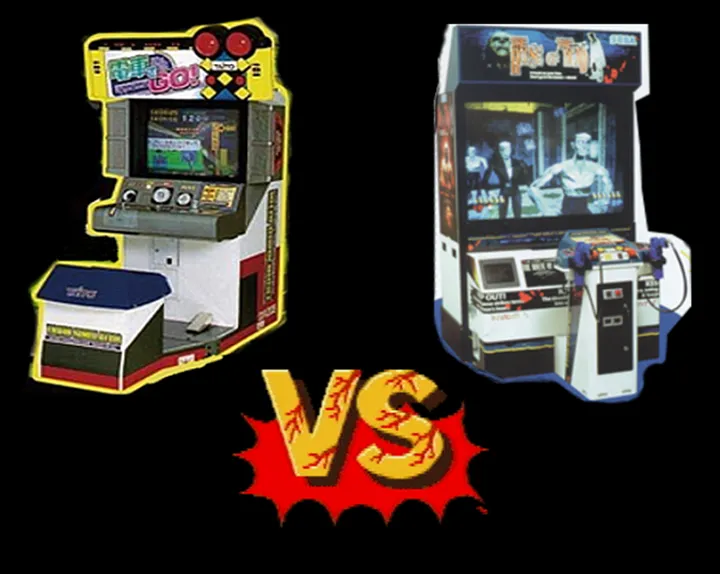It’s 1997 and we’re at the AOU show in Japan, feasting our eyes on all of the exciting up-and-coming arcade attractions on display. Over at Namco, the imminently-released Tekken 3 is an obvious headliner, but there are plenty of other goodies too — not least the array of futuristic titles Sega have running on their hugely powerful (and also stunningly expensive) Model 3 board.
Nestled in among all the flash lights and explosive sounds are two highly-impressive attractions housed in bespoke cabinets. In the red corner, we have Sega’s newest light-gun game. Themed ingeniously around b-movie horror, The House of The Dead promises an intriguing setting and a number of interesting gameplay quirks, like alternate routes hidden in the environment and enemies that can be dismembered in a number of ghoulishly novel ways. In the blue corner, we have Taito’s equally impressive Densha De Go (Let’s Go By Train) — complete with solid steel finish, chunky levers and functional gauges — which allows you to…well…drive Japanese commuter trains.
If you thought being an interactive B-movie might give Sega’s title something of an edge, you’d be in for a shock: the correspondent for the UK’s Sega Saturn magazine looks on agog as the snaking lines waiting for Taito’s machine eclipse those waiting to play House of the Dead. Though both games would ultimately lose to the knock-out fighting trio of Vampire Saviour, Tekken 3 and Street fighter 3, Densha De Go takes the highly-respectable fourth place when the time comes for the visiting public to vote for their favourite game of the show.
Surely, this must be an anomaly — an artifact of the hardcore trade show audience holding differing tastes to the public at large. A train-driving sim couldn’t dominate more traditional light gun and driving games in the real world, could it? Thankfully we don’t have to guess: every two weeks, Japanese trade magazine Game Machine interviewed arcade operators and created a chart based on their reports of the most popular and highest-earning games over the period. Who will prove to be the most popular title of 1997? The trains or the zombies?
Spring
In a move that won’t surprise anyone who’s ever caught a train in Japan, Densha De Go takes the prize for punctuality, pulling into arcades just in time for the April 15th issue of the Game Machine. Dethroning Namco’s riotous but now relatively-obscure tank combat game Tokyo Wars, Densha De Go didn’t just take the dedicated cabinet chart, but it managed to outscore Street Fighter 3, Scud Race, GTI Club and Virtual Fighter 3 by one whole point in a ten point scoring system. Only the titanic Tekken 3 and an array of popular photo sticker machines managed to score in the same bracket.
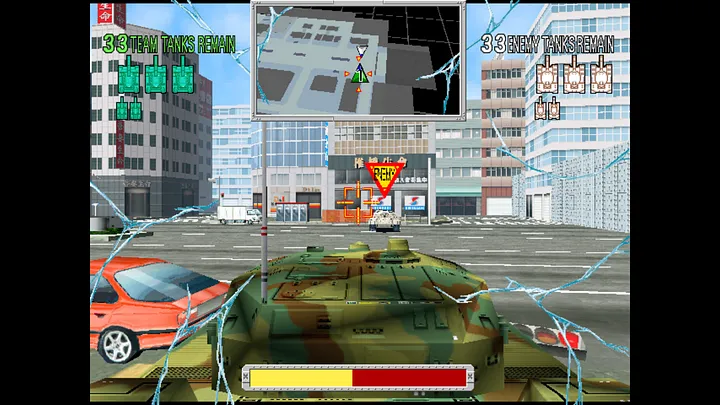
House of The Dead’s zombies and ghouls finally shuffled into arcades an issue later, dated the first of May. Though they scored a very respectable 8.25 from Japanese arcade owners, nothing could stop the Densha De Go train as it barreled down the tracks. With a score of 8.73 it had not only performed better than the previous issue, but it was the best performing video game in the charts finished only 0.02 points behind Sega’s highly successful Stamp Club sticker machine.
Mind you, If there’s one thing to say for zombies, it’s that they just keep coming and coming. Densha De Go’s trains might all have been electric or diesel, but for the next issue we find they were beginning to running out of steam. House of The Dead rose to the top of the charts, taking the top spot with a score of 8.73 to Densha De Go’s 8.53. Slightly artificial rivalry aside, this was an impressive showing from the top two dedicated cabs: their combined score of 17.26 is comfortable ahead of the scores of both Tekken 3/Streetfighter 3 at the top of the general arcade chart (15.5) AND the top two sticker machines (16.52.)
Overall, we can say that Densha De Go took the spring competition with an impressive 25.93 to House of the Dead’s 16.98 across three issues. The old adage is true — you do in fact have to be in it to win it.
Summer
After a brief delay in the middle of May, we find that by the first of June Densha De Go was back on track: kicking Sega’s ghoulies (8.00) out of the way in order to return to the number one spot with a score of 8.26.
Elsewhere, Virtua Fighter 3 dropped down to 7th in the dedicated cabinet chart — trading its 4th place with Sega quiz game Magical Zunou Power, while Scud Race swapped its original 6th place with GTI Club’s 5th. Though eclipsed slightly by our two competitors, Namco’s Tokyo Wars remained popular — holding 3rd place throughout this entire period.
In the middle of June, however, everything swapped again: the zombies clawed their way back to the top spot with a score of 8.27 to 8.20, while Tokyo Wars was finally knocked out of the top three by the arrival of Sega’s highly-ambitious deck-controlled arcade simulator Top Skater.
Moving into July, we find that the dedicated cabs aren’t performing as well as in the Spring. Whether everyone was out enjoying the summer weather or were simply across the arcade playing Vampire Savior, Densha De Go’s return to the top spot seems a hollow victory thanks to it receiving a score in the 7 bracket (7.90).
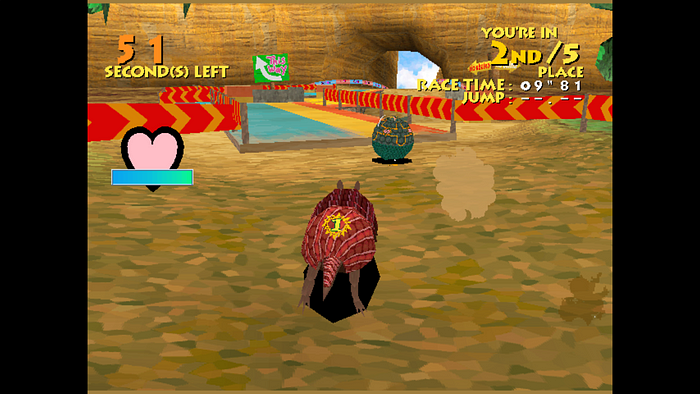
Just below, Top Skater took second place, leaving House of the Dead trailing in third on a not-entirely-distant 7.81. Tokyo Wars, meanwhile, slipped to 5th — though thankfully for Namco it was taken out by one of their own games, the delightfully silly Armadillo Racing.
By the middle of the month, however, things had swapped around again. Though Top Skater continued to act as a breakwater, the zombies were back on top with a score of 8.19 to the trains’ 8.09, providing Sega with a nice 1–2 (along with 6,8,9,10 and 13! Blimey.)
In a feat of impressive staying power, we find Densha De Go recieving another green signal t the beginning of August, with House of the Deaddropping to number two (7.74 to 7.71.) Top Skater ended up displaced further by a new entry at three for dating sim Toki Meki: Tell me Your Heart from Konami. Over in the general software chart, meanwhile, Tekken 3 returned to the top — ending the month long run of Vampire Saviour.
Once again, the titles swapped places around the middle of the month, with House of the Dead taking the top spot with a score of 8.06 to Densha De Go’s 7.67. As meteorological summer drew to a close, we find the zombies edging out the trains with a seasonal score of 47.97 to Densha De Go’s 47.86. Didn’t they do well?
Autumn
Though Densha De Go and House of the Head had been riding high for the last four months, September brought both the first autumn leaves and a fresh batch of competition. In particular, Namco launched Final furlong -an especially impressive horse racing title housed in gigantic cabinet which challenged players to sit astride giant plastic horses and physically rock them backwards and forwards to gee their mounts to to victory.
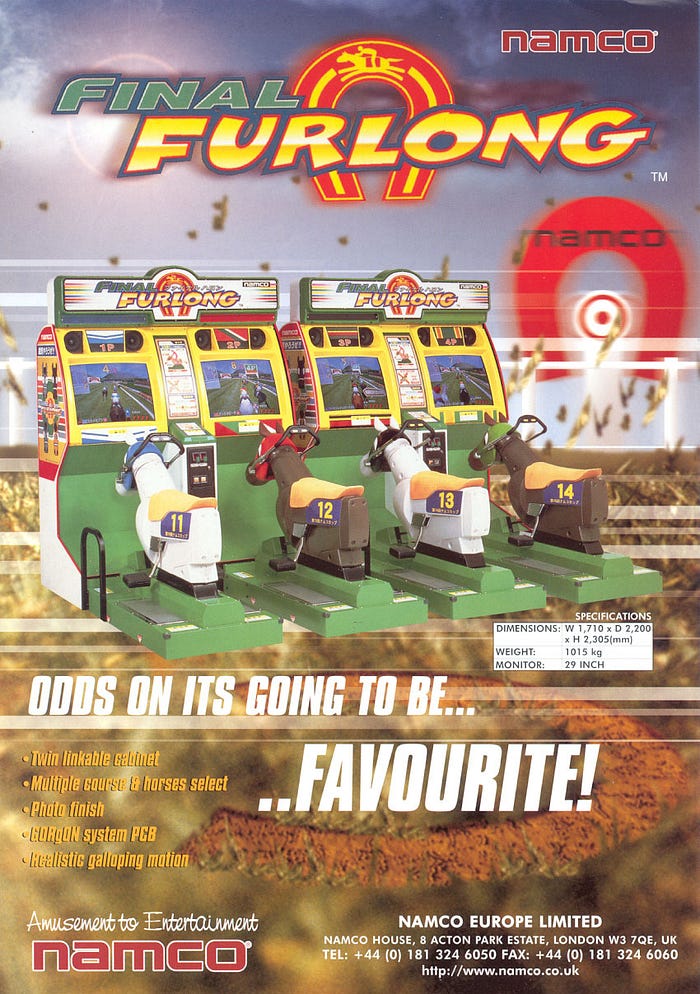
Unsurprisingly, it shot straight to the top of the dedicated cabinet charts. Receiving the only 8-bracket score that month, it knocked Densha de Go into second place with a score of 7.74. The zombies had to settle for fourth (7.32) behind another new entry, Sega’s impressive Model 3 light gun game based on The Lost World: Jurassic Park 2.Though the two arcade games were united in the middle of the month, it was in chart places three (Densha De Go, 7.70) and four (House of the Dead, 7.65), with Final Furlong and the Lost World taking the top spots.
Moving onto October, we see that the horses and dinosaurs continued to hold spots 1 and 2, but — having vanished down the charts for weeks — Sega’s Top Skater suddenly made a resurgence at number three, leaving Densha De go at four( 7.70) and House of the Dead at five (7.52.) Top Skater’s resurgence was short lived: by the middle of the month the zombies were back at number three with 7.57 and Densha De Go speeding along just behind with 7.17.
By the beginning of November, however, both The Lost World and Top Skater were back — knocking House of the Dead down to four (7.50) and Densha De Go to five (7.00.) This was, presumably, good all-roung news for Sega. For the middle of the month, Densha De Go left the station and sped back to the number two spot (7.17) while our zombie chums suffered an even more surprising drop to number 6 (6.87) in a congested field which now included Taito racer Side by Side and a new entry in the form of Sega’s Virtua Fighter 3 Team Battle. Though Autumn was a difficult month with a lot of new competition, DDG edged the season with a score of 44.48 to HOTD’s 44.43. The real story, however should perhaps be that both were fantastically popular more than six months after their respective releases, in a field of fun and eccentrically creative titles.
Winter
As Autumn made way for Winter, we find Sega’s ghouls making another resurgence, breaking through the barricades to rise from six to second in the chart with a rating of 7.48 (once again behind the unstoppable Final Furlong.) Stuck at a red light, Densha De Go found itself in fourth place behind new entrant Le Mans 24 from Sega with a score of 7.04.
This trend continued in the middle of the month, with House of the Dead hanging on to the number two spot with an even more respectable 7.65, but with Densha De Go falling down to sixth (6.64), behind the Lost World and Le Mans 24 from Sega and Taito’s own racing game Side By Side. As the smoke cleared from 1998s New Year’s celebrations, Game Machine’s bumper January issue revealed all-change: Namco knocked themselves off the top spot, with their new Rapid River finally knocking Final Furlong into second place. Densha De Go — finally getting a green signal — stormed back up three places to take bronze with a 6.86, while a series of shotgun blasts knocked Sega’s zombies back to four with a 6.70.
With the Christmas holidays doing away with any chance of a mid-January issue, we find the situation was surprisingly familiar at the beginning of February — albeit not for Rapid River, which had fallen from first to fifth. A new entry in at two for Sega with Get Bass (behind Final Furlong) left Densha De Go at three (7.48) and House of the Dead at four (7.43). For our final issue, we find that nothing had changed in the top three (with Densha De Go hanging on with a respectable 7.43) but House of the Dead dropping to fifth behind Rapid River with 7.05. HOTD takes our years coldest season but it was another relatively close battle with the victorious score 36.31 against 35.45.
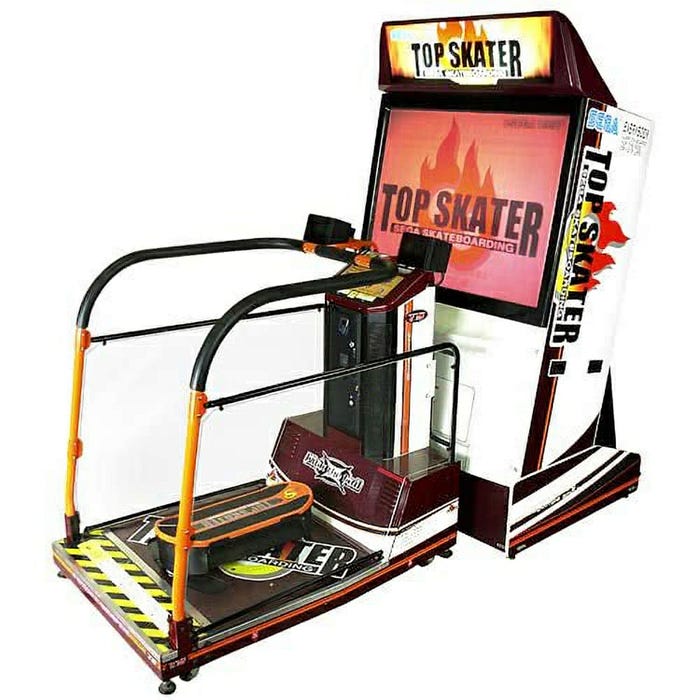
Conclusion: Forgotten Lessons
Overall then, Densha De Go’s early start proved decisive, with an overall score at the end of our period of 153.72 to House of the Dead’s 145.69. However this is where I introduce my sneaky double-cross: my purpose for writing this was never fully about our confected rivalry — I thought the whole thing would be a fun gateway to talk about a couple of pertinent points.
Having written a lot previously about the Zx Spectrum, I think it’s always important to remember that there isn’t a single, neat global history of gaming. If you’re a Western gaming enthusiast, the Densha De Go is a series you might have heard of but in Japan it was a huge deal. After going toe-to-toe in the arcades with House of the Dead and 1997’s other huge titles, the game generated multiple arcade sequels, over a million software sales in the home market and led to a mini ecosystem of novelty controllers. At an intellectual level we all understand that games can be more popular in one region than another, but Densha De Go really highlights the extent to which a game can be a console-shifting runaway success story in one market without even registering in any of the others.
While many of us understand that gaming history tends to be viewed through an American lens, we often tend to forget that we also often few video game history through a console-owners lens. While some were born at just the right time to pour dozens of their hard-earned coins into arcade games, for many the chance to interact with arcade games was a rarer treat, spending a couple of gifted pounds to experience a preview of what was to come to our home machines the following year. Unported and unportable games were an irrelevance that simply slid into the memory hole.
Because our perspective on arcade gaming often focuses on the titles that came home, our view of the market as a whole is often distorted. In this period we tend to think of Namco’s arcade output as focusing on dependable fighting and driving games, but those were only the titles that came home. As we’ve seen above, Namco were also releasing a number of experimental and ambitious titles during this period. Though many of them weren’t suitable for home porting, they were far from obscure titles that few people played: these were chart-toppers making just as much money as the likes of Dark Stalkers and Tekken in arcades all over the world. Similarly, House of The Dead is a title often talked about in the context of the shortcomings of its home port. The genius of the original version is often no more than a footnote in that discussion.
Overall then, aside from shining a light on two of 1997s most interesting releases, I hope this article has helped to show that the arcade scene of the late nineteen-nineties was more vibrant than we normally give credit for. Rather than an repetitive treadmill of 3d fighters and low-budget 2d shooters waiting to be blown away by an avalanche of rhythm games, there were plenty of developers who were prepared to grapple with the rapidly increasing power of the available technology, desperately hunting for ways to harness it into novel titles that would be compelling to play in a social setting.

